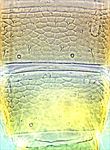Distinguishing features
Female aptera. Body and legs yellow, antennal segment VI shaded with brown. Antennae 6-segmented, VI twice as long as V, III–IV each with simple sense cone. Head longer than wide, without ocelli, without long setae. Pronotum weakly trapezoidal, without long setae. Meso and metanota transverse. Prosternal basantra with no setae; ferna almost continuous medially; meso and metafurca without spinula. Tarsi each 1-segmented. Tergites with number of discal setae variable 2–20; tergite IX posteromedian pair of setae short, about 0.2 times as long as lateral pair; tergites and sternites without craspedum; sternites with many discal setae.
Male aptera. Similar to female but smaller; sternites without pore plates; tergite IX with 2 pairs of stout thorn-like setae.
Related species
Five species are recognised in the European genus Aptinothrips. One of these, A. stylifer, is introduced to New Zealand, and is distingished by the 8-segmented antennae.
Biological data
Feeding and breeding on the leaves of grasses, but apparently not on any native Australian species.
Distribution data
Widespread in temperate climates, including montane areas of tropical countries, also widespread across southern Australia, including southern New South Wales.
Family name
THRIPIDAE - THRIPINAE
Species name
Aptinothrips rufus (Haliday)
Original name and synonyms
Thrips (Aptinothrips) rufus Haliday, 1836: 445
Thrips (Aptinothrips) nitidulus Haliday, 1836: 446
Aptinothrips connaticornis Uzel, 1895: 153
Uzeliella lubbocki Bagnall, 1908: 5
Aptinothrips intermedius Priesner, 1920: 52
Aptinothrips groenlandica Richter, 1928: 850.
References
Palmer JM (1975) The grass-living genus Aptinothrips Haliday (Thysanoptera: Thripidae). Journal of Entomology (B) 44: 175–188.





